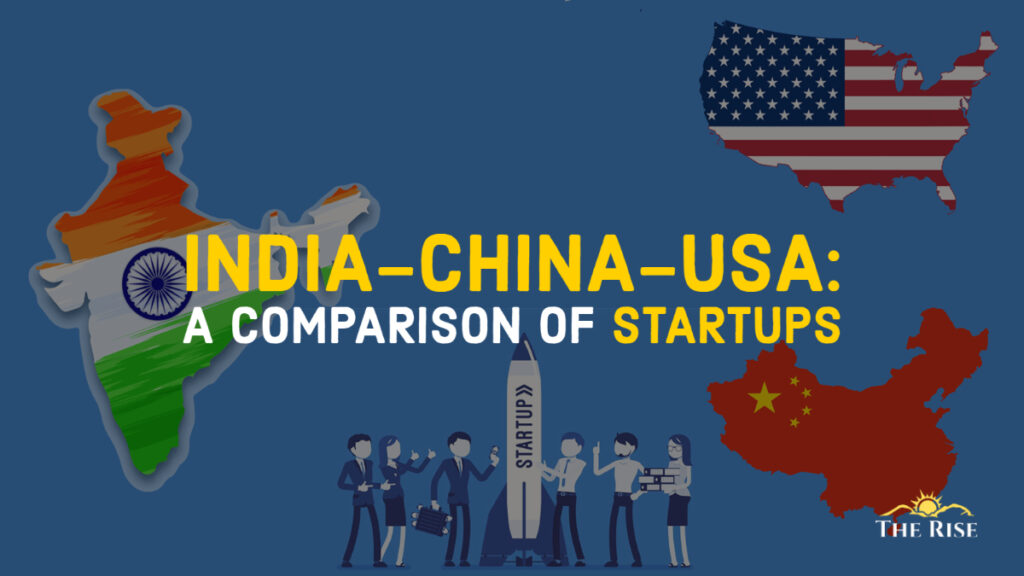The global race to become the most developed nation starts from the roots: the start-ups. India, China and the US are in the middle of intense competition to become production leaders with the former two growing at unprecedented rates. This article throws light on the policies implemented by these nations to achieve this growth and how they differ amongst them. It also looks at the upcoming markets which are expected to see an inflow of a great number of start-ups in the future.
China opened its borders for trade in the year 1978, roughly a decade before India. Today, the East-Asian nation has 206 unicorn companies and estimates suggest the presence of over 30 million start-ups. This entrepreneurial prowess did not transpire immediately. The country’s biggest financial hub, Shanghai, introduced a master plan for the years 2001-2020. This plan wanted the city to become a global hub for trade and logistics by 2020. As of 2019, the city had over 1000 start-ups, 21 unicorns, and 5000 angel investors, including Sequoia Capital and GSR Venture. The government also introduced the ‘Made in China 2025‘ policy under its 13th five-year plan in 2016 with the objective to turn the Chinese economy into a manufacturing superpower, a shift from the production of cheap mass-produced goods and services. In 2015, the State Council of China introduced Startup Ecosystem Development Strategies implementing more than 400 measures in favour of young businesses. Local governments have also actively helped businesses by providing financial support to various entrepreneurs. The most prominent of all policies, however, was Torch [1]. Launched by the Ministry of Science and Technology in 1988, this program is believed to have kick-started the Chinese start-up ecosystem. It gave rise to innovation clusters, similar to those found on the eastern and western coasts of the US, so as to provide businesses healthy competition and help them cut costs. Under it, Science and Technology Industry Parks (STIPs) were established throughout the country to assist businesses with the latest technology. By the year 2015, China had more than 2000 technology business incubators which further helped the inception of various start-ups.
The United States’ start-ups can be dated as far back as the 1970s when the term ‘Silicon Valley‘ was first coined in a magazine primarily because companies in California were engaged in the production of semiconductors. Since then, America’s start-up ecosystem has grown partly because of government policies and partly because of the nature of entrepreneurship there. In the early 2000s, the internet boom helped businesses develop their business ideas. It gave rise to unique customer demands and the risk-tolerant American entrepreneur did not hesitate to tap the opportunity. This is one of the most significant reasons why America leads the start-up ecosystem globally. Entrepreneurs, there are more open to new and unconventional business ideas and do not fear the risks that accompany. This can be attributed to the ease in funding for American start-ups. In the year 2020 alone, investors injected over $156 billion into domestic start-ups, an increase from around $140 billion in 2018 and 2019. The lenient government regulation makes setting up businesses even easier. According to the Doing Business Report by World Bank, it takes only 4 days for an entrepreneur in the US to start a business. Further government policies like ‘Start-up America’ from 2011 along with ‘Start-up America Partnership’ help businesses with their capital requirements, reduce barriers to entrepreneurship and accelerate innovation.
Policy Differences between the US, China, and India
India, China, and the US account for over 82% of total unicorns worldwide [2]. While the US dominates this tally with a 64% share, China and India are chasing faster than any other nation and it becomes pertinent to compare the policies and ecosystems of these nations.
According to Forbes, 55% of America’s unicorns have an immigrant founder. Yet, American law does not make it easy for entrepreneurs from foreign lands to start up a business. Despite having several visa categories for entrepreneurs, the law does not guarantee a green card to a person on the basis of entrepreneurship. Most entrepreneurs are tethered to their sponsored employers or companies for visas and still end up getting denied a green card. Similarly, an Indian business visa is not start-up friendly and the entire process is plagued by excessive bureaucracy. China, on the other hand, has piloted a ‘start-up’ visa in districts like Shanghai, Changning, and Yangpu which houses even inexperienced individuals and entrepreneurs over 60 who were previously rejected under the traditional business visa norms.
You May Like: Introspecting Digitalization in the Indian Economy
When it comes to nurturing businesses, China provides its entrepreneurs with over 11,000 incubators which in 2018 assisted 6,20,000 start-ups. These incubators can pay corporate tax as low as 10% depending upon the scale of their operations and are extended loans at low interest rates. In comparison, the US has 1400 incubators and states like New York exempt eligible incubators from state corporate income tax and state sales tax. India has only around 520 and yet incubators in India are taxed like other companies and are obligated to bear several direct and indirect taxes along with a corporate tax of 25% plus surcharge [3]. This discourages the development of more incubators and leads to less private participation. The US government has special grants for start-ups like the Small Business Innovation Research (SBIT) program and Small Business Technology Transfer (SBTT). These have been designed to help American-owned and operated small businesses to engage in research and development needed to commercialize their ideas. The US also receives the most venture capital investments in the world, although concentrated mostly in the West and North-East coasts of the country. China trails the US in the number of venture capital investments but has lately shown a downward trend. Several reports cite the US-China trade tensions and China’s economic slowdown to be the reasons behind the lack of interest from investors in the country.
The Indian government has numerous schemes for start-ups like the Venture Capital Scheme for start-ups related to agriculture and MSME Market Development Assistance which helps businesses expand their operations through international trade fairs and exhibitions. In addition, states like Gujarat, Karnataka, Rajasthan, UP, Bihar, and Kerala have their own venture capital funds established by the state governments to assist local entrepreneurs in funding. The central government also created a Fund of Funds for Start-ups with a corpus of 10,000 crores in 2016 managed by the Small Industries Bank of India (SIDBI).
You May Like: Rebooting Infrastructure: National Infrastructure Pipeline Dashboard
Sectoral Distribution of Start-ups in US & China
The start-up ecosystem in the US is completely integrated with technology. Take artificial intelligence for instance. AI companies raised $33 billion dollars in the year 2020 despite the ongoing pandemic. UiPath, a New York-based robotic process automation company, reached a valuation of $35 billion in February 2021. Big data is also expected to witness an increase in compound annual growth rate (CAGR) of 12.5% to $192 billion dollars by 2023. Cybersecurity has also been seeing an increase in funding lately with $7.8 billion raised in 2020 alone, a 22% increase over investments received in 2019. Experts opine that in a decade, sectors like autonomous transportation, life science, digital health, and cleantech will become the most popular.
Just like the US, AI is also catching pace in China. The country has 1,189 AI firms, second only to the US which has more than 2,000. These Chinese firms focus more on speech recognition and synthesis and image and video recognition than other countries [4]. Robotics is another growing field in the country which is heavily supported by the Chinese government. The country has popular start-ups like SenseTime, Reis Robotics and Geek+ along with around 6,000 more companies in this sector. The robot density of the country has been increasing and in 2016, it was the most dynamic in the world as per the International Federation of Robotics (IFR). Apart from this, BioTech has seen a boom in China owing to a rise in the number of biotech science parks by 50% from 2016-2020. The country has seen an influx of its own scientists and researchers from abroad due to generous government grants and subsidies. China is also the most lucrative market for gaming-related start-ups followed by the US. Housing the world’s largest video game publisher Tencent and over 700 gaming start-ups the market was valued at $58 billion in 2020 and is estimated to reach $86 billion by 2027 [5].
Like its counterparts, India has also witnessed a substantial rise in these sectors. AI start-ups in the country saw the greatest amount of funding in 2020 in seven years. The robotics market in India is expected to have a CAGR of 14.41% between 2020-2025. In 2018, India was the 11th largest industrial robot installation market in the world, ahead of Canada, Czech Republic, and Singapore. The HR technology industry is expected to reach a valuation of $34 billion by the end of 2021 and $3.6 billion worth of the business is expected to come from Asia including India. Due to the rise in 5G connections, the greater number of internet users every year, and the advent of technologies like virtual reality and augmented reality, India’s gaming market is expected to be valued at $3.8 billion by 2024. To support this, the Indian government has also decided to set up an Animation, Visual Effects, Gaming and Comic (AVGC) Centre for Excellence in collaboration with IIT Bombay and states like Karnataka, Telangana, and Maharashtra have already implemented this policy.
Also Read: Understanding Indian Startup Ecosystem
REFERENCES
- Torchbearer: Igniting Innovation in China’s Tech Clusters’ by Damien Ma, https://geip.sg/network/shangha
- USC Marshall School of Business – Startup Index of Nations and Regions, https://www.marshall.usc.edu/faculty-research/centers-excellence/center-global-innovation/startup-index-nations-regions
- Incubation Systems for Start-ups in China and India: A comparison of the two ecosystems’ by Hrishikesh Kayshap, https://icsin.org/blogs/2020/08/13/incubation-systems-for-start-ups-in-china-and-india-a-comparison-of-the-two-ecosystems/
- Harvard Business Review, ‘Is China Emerging as the Global Leader in AI?’, February 18, 2021, by Daitian Li, Tony W. Tong and Yangao Xiao, https://hbr.org/2021/02/is-china-emerging-as-the-global-leader-in-ai
- Global Newswire ‘China Online Gaming Market Report 2021’, May 4, 2021, https://www.globenewswire.com/en/news-release/2021/05/04/2222088/28124/en/China-Online-Gaming-Market-Report-2021-Market-was-Valued-58-Billion-in-2020-and-is-Expected-to-Reach-to-86-Billion-by-2027-Top-Players-are-Tencent-NetEase-Kingsoft-Changyou-Shanda-.html
















Pingback: Indian Startups Leading The Way in COVID-19 - TheRise.co.in
Pingback: Zomato Goes Public. Yet, 90% Indian Startups Fail within 5 years. Why?